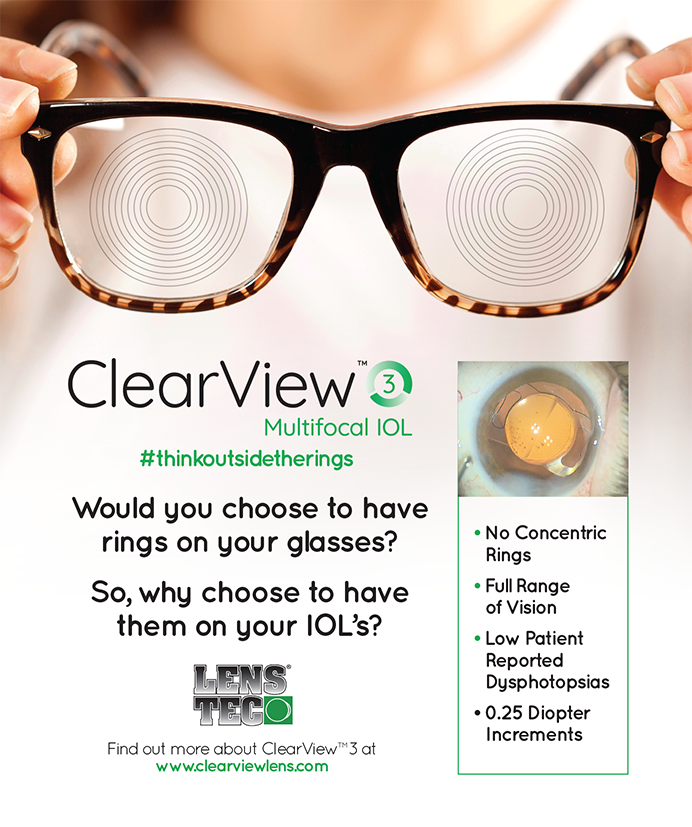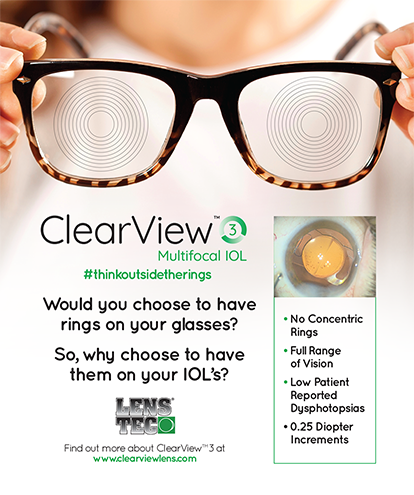The advent of presbyopia-correcting IOLs opened a door for the precataract baby boomers. Theoretically, these individuals have independent lifestyles and a willingness to undergo elective surgical procedures that may enhance their standard of living. Serendipitously, refractive lens exchange is often easier and safer to perform then traditional cataract surgery, because a fully developed lenticular pathology is not yet present. A patient whose visual acuity can be readily refracted to nearly 20/20 prior to surgery, however, is more demanding of his postoperative visual outcome than one whose cataract has long since severely compromised his visual acuity, night vision, and contrast sensitivity. This article discusses my experience with presbyopia-correcting IOLs, with an emphasis on mixing the Crystalens accommodating IOL (Eyeonics, Inc., Aliso Viejo, CA) and the AcrySof Restor lens (Alcon Laboratories, Inc., Fort Worth, TX).
TWO PRESBYOPIA-CORRECTING IOLS
The Crystalens
Currently, there are two distinct categories of presbyopia-correcting IOLs: accommodating and multifocal (both refractive and diffractive). These lenses work in significantly different fashions, and both have strengths and weaknesses.
As the first accommodating IOL on the US market, the Crystalens presented surgeons with a steep learning curve but allowed them to provide patients with quality distance and intermediate vision, albeit with mixed results in terms of consistent reading vision. Although most patients were quite pleased with the Crystalens, many needed supplemental readers postoperatively for sustained near work. A formerly 3.00 D hyperopic presbyope may not mind wearing reading glasses, but a former -3.00 D myope may be dissatisfied.
The AcrySof Restor Lens
The AcrySof Restor lens, introduced shortly after the Crystalens, uses concentric multifocality with apodization to suppress image-related confusion and internal reflectivity in presbyopes. This lens provides 3.50 D of magnification at a typical reading distance of 12 to 14 inches. Undesirable optical side effects include an unsatisfactory intermediate focal point (18 to 35 inches) and what many early recipients of the lens described as waxy vision.
The source of this waxiness can be identified by comparing the modulation transfer function of the AcrySof Restor and Crystalens under in vitro conditions (Figure 1). The steep drop-off in the modulation transfer function curve is indicative of a significant loss of contrast across a wide range of frequencies that is perceived as (among other things) a loss of crisp edges and a general difficulty in perceiving objects with less-than-brightly-lit backgrounds with both lenses. This reduction in the area under the curve is roughly equivalent to the Strehl ratio, a measure of the overall quality of any optical device and is also evident in vivo. This drastically decreased area under the modulation transfer function curve reflects a significantly negative impact on overall visual acuity. The modulation transfer function curve's "cutoff," or where that curve drops to the x-axis is also clinically significant. This cutoff corresponds to the best visual acuity achieved by the lens, and often indicates where there has been a loss of best spectacle corrected acuity, especially in the better than 20/20 ranges. The cutoff can also be objectively determined in vivo using the double-pass technique employed by the Optical Quality Assessment System (Visiometrics, SA, Terrassa, Spain).
MIXING IOLS
The rationale for combining the Crystalens and the AcrySof Restor IOL in a single patient is twofold. First, the pairing provides maximum visual acuity at distance because of the higher resolution and better optical performance of the accommodating IOL. Surgical planning typically dictates putting the Crystalens in the patient's dominant eye and the AcrySof Restor in his fellow eye. Second, this strategy in my experience achieves better-quality visual performance at intermediate and close reading distances than bilateral maximally distance-targeted accommodating IOLs.
Assuming that the patient tolerates the different optics of the two IOLs, both of his eyes will perceive equal levels of acuity at distance under bright lighting conditions, based on my experience. His dominant eye's perceived image, however, will have significantly higher levels of contrast sensitivity, which will provide finer levels of visual discrimination that would otherwise be adversely affected under dim lighting conditions (the depressed modulation transfer function of the multifocal IOL). At close reading distances (11 to 13 inches), however, the AcrySof Restor can relieve the accommodative strain on the ciliary muscle through the high magnification inherent in its design. At intermediate distances, there is typically enough accommodation associated with the Crystalens to comfortably meet my patients' moderate accommodative demand, especially when they use the computer. In my experience, the bilateral AcrySof Restor patients' most frequent complaint is poor intermediate distance vision, and the mixed-IOL strategy relieves this problem.
Does mixing the Crystalens with the AcrySof Restor lens work in the real world? Although it is probably not the best possible solution to every presbyope's need, I find the combination is effective and often works better than bilaterally matched presbyopia-correcting IOLs (Figure 2).
Studies
According to a prospective, nonrandomized cohort of 50 consecutive patients undergoing refractive lens exchange in which the Crystalens was implanted in their dominant eye and the AcrySof Restor in their other eye, 100 saw at least 20/32 binocularly and the equivalent of 20/40 at both near and intermediate distance.1 These results compare with a series of 13 consecutive bilateral IOL patients who received either two AcrySof Restor lenses or two Crystalens AT45 IOLs (Eyeonics, Inc.).2 As expected, near vision was better in patients with bilateral AcrySof Restor lenses, and intermediate vision over an impressive depth of field was better in patients with bilateral Crystalens IOLs. This conclusion is based on a recent clinical study we did in which a prospective, matched, nonrandomized set of 15 patients in each of two groups received bilateral presbyopia-correcting IOLs (Crystalens AT45 or AcrySof Restor). We compared these two groups with a previous cohort of mixed patients (Crystalens in the dominant eye, AcrySof Restor in the fellow eye).
Postoperative Vision
What may dissatisfy patients about a mixed-IOL approach? I find it is rarely a perceptual disparity in viewing at distance. The occasional person will spontaneously mention a waxy image through the multifocal IOL. Even when questioned about waxy vision specifically, those who notice a difference will relate it more often to the close reading distance and describe letters as having "ghost image" edges. The high degree of magnification of the AcrySof Restor lens at about 12 inches will often be compared preferably to that of the Crystalens at that same distance.
Intermediate distance vision is rarely, if ever, a source of complaints in those of my patients with mixed IOLs. Most are unaware that their two eyes see differently at 14 to 36 inches . This finding coupled with my patients' extremely high degree of satisfaction with their distance vision (under all conditions: scotopic; mesopic; and photopic) has convinced me that the AcrySof Restor/Crystalens combination works well for refractive lens exchange in most of my patients over age 50 (my rough cutoff age when selecting patients for this surgery).
CONCLUSION
I anticipate combining the Crystalens and AcrySof Restor lens at least until Alcon Laboratories, Inc., releases a ±1.50 D-add model of its multifocal IOL. It will be interesting to see whether the company's forthcoming aspheric version of the lens will significantly improve its modulation transfer function. If so, the current drawbacks of bilaterally implanting the AcrySof Restor lens will decrease dramatically.
As manufacturers improve the degree of dioptric or linear magnification at near with accommodating IOLs like the Crystalens, the relative advantage of the AcrySof Restor lens will disappear. Once accommodating IOLs provide a dependable range of magnification at near without an unreasonable demand on accommodative reserve, I believe that they will completely replace multifocal IOLs because of their superior optical performance, as documented objectively by modulation transfer function and subjectively by patients' satisfaction.
J. Trevor Woodhams, MD, is Surgical Director of the Woodhams Eye Clinic in Atlanta. He acknowledged no financial interest in the products or companies mentioned herein. Dr. Woodhams may be reached at (770) 394-4000; twoodhams@woodhamseye.com.


